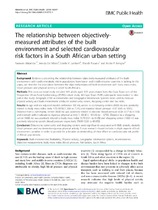The relationship between objectively measured attributes of the built environment and selected cardiovascular risk factors in a South African urban setting
Date
2018Author
Malambo, Pasmore
De Villiers, Anniza
Lambert, Estelle V.
Puoane, Thandi
Kengne, Andre P.
Metadata
Show full item recordAbstract
BACKGROUND: Evidence concerning the relationship between objectively-measured attributes of the built
environment with cardio-metabolic risk in populations from lower- and middle-income countries is lacking. In this
paper, we describe the association between the objectively-measured built environment with body mass index,
blood pressure and physical activity in adult South Africans.
METHODS: This cross-sectional study included 341 adults aged ≥35 years drawn from the Cape Town arm of the
Prospective Urban Rural Epidemiology (PURE) cohort study. All Cape Town PURE participants were invited to take
part in the study. Actigraph GT3X accelerometer and Geographic Information Systems were used to measure
physical activity and built environment attributes (community center, shopping center and taxi rank).
RESULTS: In age and sex adjusted models (reference 500 m), access to community centers (1000 m) was positively
related to body mass index [beta 4.70 (95%CI: 2.06 to 7.34)] and diastolic blood pressure [4.97 (0.00 to 9.95)].
Distance from a community center (1600 m) was positively related to diastolic blood pressure [6.58 (1.57 to 11.58)]
and inversely with moderate-to-vigorous physical activity [− 69.30 (− 134.92 to − 3.70)]. Distance to a shopping
center (1600 m) was positively related to body mass index [4.78 (1.11 to 8.45)] and shopping center (1000 m) was
positively related to systolic blood pressure respectively [76.99 (0.03 to 83.95)].
CONCLUSION: Distance to community and shopping centers were significantly associated with BMI, systolic, diastolic
blood pressure and moderate-to-vigorous physical activity. Future research should include multiple aspects of built
environment variables in order to provide for a broader understanding of their effect on cardiovascular risk profile
of African populations.

